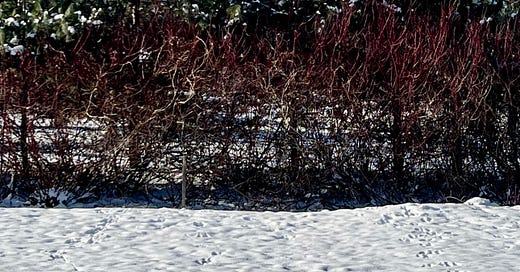Grow a Living “Fence”
My plans, along with instruction on how to grow free bushes from hardwood cuttings.
The other day, while walking the dog, I noticed that a neighbour’s red osier dogwood “fence” was intensely colourful in the high key, mid-day winter sun. I was unable to capture its beauty with my phone’s camera from a distance, but the bare, deep red branches against the white snow and bright blue sky was stunning. Our house is in the centre of a row of 6 with unusually long, large yards that are backed by a common 9-acre woodlot (owned by someone else). The yards are mostly unfenced so I can see these bushes all the way from our yard even though they are two houses away. The dense bushes have created a safe haven for songbirds and even from a distance I can hear the raucous population chirping away on a sunny day. A tangle of red dogwood bushes may seem simple and overdone—dogwoods are a dime a dozen in these parts. Our neighbour in Toronto had a variegated cultivar that grew through the fence, providing me with a handful of fresh garden stakes every spring. However, I find red dogwoods are extremely useful bushes to have around in general (I outline their many uses in this post) and observing, over the last 3 years of living here, the life that congregates at my neighbour’s, has served as inspiration to do something similar in this yard. Dogwoods are extremely adaptable to all sorts of environments—from small yards to big ones like mine. Even if your climate is different and requires different plants, you may find some inspiration for your garden too. Allow me to explain.
Shown above is the property line on the eastern side of the yard, which is mostly lined with young cottonwood and red maple trees. This is a portion of the area that I am referring to.
My Vision
I love that our 6 yards are mostly open. There are no barriers to wildlife and I want to keep it that way. However, there is also no privacy, and while in an ideal world I would love these interconnected yards to work together, sort of like a community garden with shared food growing and a commitment to creating wildlife habitat, it’s not reality. My kind of gardening is not the norm here, and it’s starting to feel as though creating some kind of visual block will reduce anxiety coming from some of the neighbours we work to transform the large swath of lawn into a diverse ecosystem. My plan is to slowly plant a living fence that will act as a visual barrier between our yard and the people to the east, while also growing increased habitat for wildlife—most notably our large songbird population. Planting bushes and plants that grow edible berries and seeds will also create more food sources for them.
An image of the same trees taken earlier this year. Here you can see that while an overstory is developing, and there is even a bit of a understory of mostly non-native grasses showing up as we no longer mow underneath, there is no middle ground.
While the neighbour’s living dogwood fence sits out in the open, ours will be a middle story beneath the trees that line the property. Currently, the oldest, tallest trees are cottonwoods, red and silver maples, and northern catalpa. I don’t think any of these trees were planted intentionally, but likely came up on their own and were then left alone to grow. They must not be very old because the line is empty on satellite maps that are at least 5+ years old. Since last year, we have added a few Carolinian Zone natives to fill in a big gap in the line, with the hope that, in time, it will all be lined with tall trees, a middle story of shrubs, and an understory of flowering, herbaceous perennials below. The trees we’ve added include: another red maple, paper birch, and a Kentucky coffee.
Over the last year we have been building thin, long hugelbeds (no-dig raised beds created by layering wood logs, branches, and other plant materials) just in front of the trees. In a few years, once the materials have broken down, they will serve as garden beds that will sit just outside the shade of the trees and bushes, which will increase as they grow. Normally, building beds upwards wouldn’t be required, but the soil out there is intensely clay, and the property line is actually a shallow ditch that fills with water in the wet season. The cottonwoods love the moisture so I want to preserve that trough for them while also creating growing conditions for a wider range of flowering plants that prefer loamier soil.
Some of the red osier dogwood (Cornus sericea) we’ve been encouraging at the back of the property underneath the edge of the woodlot. I’ve been planting cuttings here too.
Keep reading with a 7-day free trial
Subscribe to Grow Curious to keep reading this post and get 7 days of free access to the full post archives.







